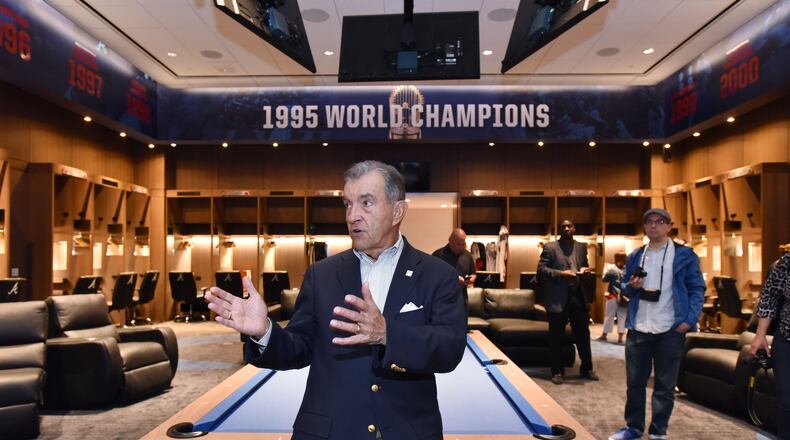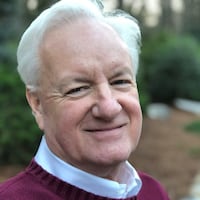Like many of us, John Schuerholz cannot believe it has been 25 years.
“No, that’s impossible,” he said. “It is a glorious memory in my mind. I have a lot of great ones, but that one is right up there at the top.”
Somehow, it was indeed 25 years ago that the Braves won the World Series, the only one they have won since moving to Atlanta.
“That team didn’t just suddenly show up in 1995,” Schuerholz, the Braves’ general manager at the time, said in a recent interview with The Atlanta Journal-Constitution. “It was a building process that began when Bobby Cox was general manager, and he and (former long-time Braves scouting director) Paul Snyder focused on gathering the most talented amateur players they could.”
The building of the 1995 World Series champions can be traced well back into the 1980s.
MORE FROM THE SERIES
» About the series» FURMAN BISHER: Atlanta's finest moment
» SPRING TRAINING: Starting with replacement players
» MARK BRADLEY: A subdued season, a giddy ending
-♦-
In June 1984, Snyder and staff selected a Massachusetts high school pitcher and hockey player named Tom Glavine in the second round of the amateur draft. In the fourth round a year later, they drafted an outfielder and basketball player from Thomas More College in Kentucky, David Justice.
Cox became the Braves’ general manager in October 1985, and 22 months later he made the best trade in franchise history, acquiring minor-league pitcher John Smoltz from the Detroit Tigers for veteran pitcher Doyle Alexander. In June 1990, Cox and Snyder selected high school shortstop Chipper Jones with the No. 1 pick of the draft after pitcher Todd Van Poppel insisted he wouldn’t sign if chosen.
By 1995, Glavine, Justice, Smoltz and Jones were key players on Atlanta’s championship team. Glavine pitched eight spectacular innings of one-hit ball as the Braves silenced the fearsome Cleveland Indians offense to win the decisive Game 6 of the World Series, 1-0. Justice hit a home run to provide the game’s only scoring. Jones, having moved from shortstop to third base, was runner-up for the National League rookie-of-the-year award that season.
Although the 1995 Braves were remarkably homegrown – six of their eight starting position players were drafted or signed by the organization from 1983-90 – the team presumably wouldn’t have won the World Series without players added by Schuerholz. He joined the Braves from the Kansas City Royals as general manager in October 1990 after Cox moved from the front office to the dugout for his second stint as the team’s manager.
Of Schuerholz’s many moves, three in particular had a large impact on the 1995 championship season: the acquisitions of pitcher Greg Maddux in December 1992, first baseman Fred McGriff in July 1993 and center fielder Marquis Grissom in April 1995.
Maddux was coming off a 1992 Cy Young Award-winning season with the Chicago Cubs when the Braves signed him as a free agent to a five-year, $28 million contract. There’s a compelling backstory to the best free-agent signing in Braves history: The team wouldn’t have had the money to pursue Maddux, Schuerholz said, if a blockbuster trade with the Pittsburgh Pirates hadn’t fallen through nine months earlier during 1992 spring training.
“I made a trade for Barry Bonds!” Schuerholz said. “The deal was agreed to with Ted Simmons, who was then the general manager of the Pirates. He took it to their manager, Jim Leyland, who stormed into the owner’s office and said, ‘We can’t trade Barry Bonds!’ And the owner unplugged the deal.”
The deal would have sent relief pitcher Alejandro Pena, outfielder Keith Mitchell and a prospect-to-be-named-later from the Braves to the Pirates for Bonds. For about 15 hours by Schuerholz’s count, the deal was done, although not announced. Then it was undone by the Pirates.
“So after that happened, the money we had earmarked for the cost of Bonds’ salary was used to attract (Maddux),” Schuerholz said. “The money we were going to spend on the best hitter in the game, we used instead to get the best pitcher.”
Maddux accepted less money to sign with the Braves than the New York Yankees were offering. He won the Cy Young award in each of his first three seasons with the Braves, giving them a rotation for the ages with three future Hall of Famers (Maddux, Glavine, Smoltz).
Left forever unanswerable was the question of how baseball history would have been altered if the Braves had acquired Bonds – but not Maddux.
The Braves weren’t a great offensive team in 1995, finishing 21st of 28 MLB teams in runs scored, but that wasn’t the fault of cleanup hitter McGriff, who led the team in home runs with 27 and RBIs with 93. Schuerholz acquired him from the payroll-slashing San Diego Padres two years earlier for three minor leaguers: outfielders Melvin Nieves and Vince Moore and pitcher Donnie Elliott. The surrendered players weren’t the Braves’ most prized prospects at the time.
“No, but they sure as hell sounded like it when I was on the phone (with the Padres),” Schuerholz recalled with a laugh.
Schuerholz acquired Grissom on April 6, 1995, four days after the end of the players’ strike that had canceled the 1994 World Series, from the salary-dumping Montreal Expos for outfielders Tony Tarasco and Roberto Kelly and pitching prospect Esteban Yan. Before that price was agreed upon, the Expos had asked for young left fielder Ryan Klesko, who would remain with the Braves and hit 23 home runs during the 1995 season (and three more in the World Series).
“Trades never come together easily because everybody you’re dealing with wants to get the biggest pound of flesh they can get,” Schuerholz said. “We wanted, No. 1, to get (Grissom), and we wanted, No. 2, to limit the damage to our assets that we had left behind after the deal was made.”
Grissom was the final high-profile player added to the Braves’ roster for 1995, and fittingly he would catch the final out of the World Series.
The Braves won the National League East by 21 games that season and rolled through the Colorado Rockies and Cincinnati Reds in the NL playoffs. Then, in Atlanta-Fulton County Stadium on the night of Oct. 28, 1995, the team painstakingly built by Schuerholz, Cox, Snyder and others won the World Series. That it did so by posting a staff ERA of 2.67 in the series and limiting the Indians to a .179 team batting average reaffirmed the pitching-dominant philosophy with which the 1990s Braves operated.
The 1995 Indians, featuring the sluggers Albert Belle, Manny Ramirez and Jim Thome among others, “were the best hitting team that maybe I’ve ever seen,” Schuerholz said. “Go back and look at that roster and who they were. I mean, they’d knock your socks off. But thankfully, our pitchers knocked their socks off.”
Schuerholz, now 79, was the Braves' general manager through the 2007 season and team president from 2007-16. He now holds the title of Braves vice chairman emeritus and a berth in the baseball Hall of Fame. The 1995 Braves – indeed, the team's 14 consecutive division titles from 1991 through 2005 – remain a source of immense pride and joy to him.
“It just reminds me, sitting here talking to you about it, how fortunate I was to join the organization,” Schuerholz said. “To have been able to work shoulder to shoulder with one of the greatest people I’ve ever known in my life, Bobby Cox, still puts a smile on my face to this day.
“We worked hard, and we had fun. We weren’t frivolous, but we enjoyed putting good teams together and winning games. Thinking about it makes me feel very, very good.”
Credit: Curtis Compton
Credit: Curtis Compton
HOW THE 1995 BRAVES WERE BUILT
Starting position players
C Javy Lopez, signed as an amateur free agent in 1987
1B Fred McGriff, acquired from San Diego in a July 1993 trade
2B Mark Lemke, drafted in 27th round in 1983
SS Jeff Blauser, drafted in first round of secondary phase in 1984
3B Chipper Jones, drafted in first round (No. 1 overall pick) in 1990
LF Ryan Klesko, drafted in fifth round in 1989
CF Marquis Grissom, acquired from Montreal in April 1995 trade
RF David Justice, drafted in fourth round in 1985
Reserves
C Charlie O'Brien, signed by Braves as a free agent in November 1993
IF Rafael Belliard, signed as a free agent in December 1990
IF Mike Mordecai, drafted in sixth round in 1989
OF Mike Devereaux, acquired from the Chicago White Sox in an August 1995 trade
OF Mike Kelly, drafted in first round in 1991
OF Luis Polonia, acquired from the New York Yankees in an August 1995 trade
OF Dwight Smith, signed as a free agent in April 1995
Starting pitchers
Greg Maddux, signed as a free agent in December 1992
Tom Glavine, drafted in second round in 1984
John Smoltz, acquired from Detroit in August 1987 trade
Steve Avery, drafted in first round in 1988
Kent Mercker, drafted in first round in 1986
Relief pitchers
Mark Wohlers, drafted in eighth round in 1988
Greg McMichael, signed as a minor-league free agent in April 1991
Brad Clontz, drafted in 10th round in 1992
Pedro Borbon, signed as a minor-league free agent in August 1989
Steve Bedrosian, signed by Braves as a free agent in December 1992*
Alejandro Pena, acquired from Marlins in August 1995 trade*
*Bedrosian also had a previous stint pitching for the Braves in 1981-85, as did Pena in 1991-92. Not all players who appeared in games with the Braves in 1995 are listed.
About the Author
Keep Reading
The Latest
Featured




